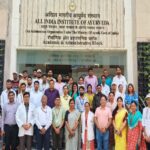Second COVID-19 infection more severe than first infection in 4 Mumbai health workers
[Excerpts from TOI story by Malathy Iyer]
- COVID-19 reinfection has been confirmed using whole genome sequencing in four healthcare workers from Mumbai.
- All of them have a more severe infection as compared to the earlier episode, reports a preprint published on The Lancet medical journal’s website.
- The reinfected patients include three doctors from the BMC-run Nair Hospital, and another healthcare worker from Hinduja Hospital, Mahim.
- The investigation was conducted by the two hospitals along with the Institute of Genomics and Integrative Biology (IGIB) and the International Centre for Genetic Engineering and Biotechnology (ICGEB) in Delhi. It revealed 39 mutations within eight genomes (four samples each of the first infection and four samples from the second infection).
- For all these healthcare workers, the second episode had more symptoms; constitutional manifestations and illness persisted for a longer time than the first episode.
- Main authors of the paper include Dr Jayanthi Shastri from Nair Hospital and Dr Sujatha Sunil from the ICGEB.
- An RT-PCR positive test does not confirm reinfection. Reinfection can be confirmed only by whole genome sequencing (WGS) of the viral isolates from different episodes.
- The first infection was asymptomatic to mild in these healthcare workers, but all of them required hospitalization during the second infection.
- One of the patients was given convalescent plasma therapy and another was unable to resume routine activities and work for three weeks.
- None of them developed breathlessness or infection in the lower respiratory tract.
- Reinfection cases have reported from across the globe ever since the first confirmed case was reported in Hong Kong a month ago. Cases have been reported in Nevada (United States), Belgium and Ecuador. India’s first reinfection cases were reported a few weeks back from Noida.
- Phylogenetic analysis of the eight complete sequences with 52 other samples from India obtained from April-July revealed that these samples clustered together, suggesting that they were part of the same larger clade and closely aligned to the Wuhan reference strain.
- Investigators noted that the re-infected health workers had D614G mutation, which has a spike protein that makes it easier for the virus to infect people. The D614G mutation is associated with severe infections.
- The second infection was severe only in comparison to their earlier infection.
Dr KK Aggarwal
President CMAAO, HCFI and Past National President IMA
healthysoch







